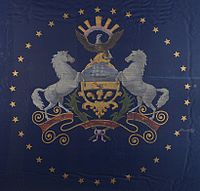
The Pennsylvania Reserves were an infantry division in the Union Army during the American Civil War. Noted for its famous commanders and high casualties, it served in the Eastern Theater, and fought in many important battles, including Antietam and Gettysburg.

The 24th Michigan Infantry Regiment was an infantry regiment that served in the Union Army during the American Civil War. It was part of the Union Iron Brigade.
The 54th Pennsylvania Volunteer Infantry was an infantry regiment which served in the Union Army during the American Civil War.

The 105th Pennsylvania Volunteer Infantry was an infantry regiment which served in the Union Army during the American Civil War. Among the regiment's early recruits was future United States Congressman Albert C. Thompson.

Jacob Gellert Frick Sr. was a United States infantry officer who fought with several Union Army regiments during the American Civil War, including as lieutenant colonel of the 96th Pennsylvania Infantry and as colonel of the 129th Pennsylvania Infantry. He received his nation's highest award for valor, the U.S. Medal of Honor, for his gallantry during the battles of Fredericksburg and Chancellorsville, Virginia. Grabbing the American flag from his regiment's color-bearer at Fredericksburg on December 13, 1862, he inspired his men to move forward "through a terrible fire of cannon and musketry"; at Chancellorsville, he personally engaged in hand-to-hand combat on May 3, 1863, to retrieve his regiment's flag which had been captured by the enemy. He was 67 years old when his Medal of Honor was conferred on June 7, 1892.

The 91st Pennsylvania Volunteer Infantry was a Union infantry regiment which fought in multiple key engagements of the American Civil War, including the Battle of Fredericksburg, Battle of Chancellorsville and Battle of Gettysburg. It was established through the combined efforts of Edgar M. Gregory, who had received approval from the U.S. War Department to begin recruiting soldiers for an entirely new regiment during the fall of 1861, and Edward E. Wallace, who had initiated his own recruitment efforts that October. Their recruits were volunteers, the majority of whom initially enlisted for three-year terms of service from their hometown of Philadelphia; they were divided into 10 lettered companies upon muster in during early December 1861: A, B, C, D, E, F, G, H, I, and K.
The 75th Regiment Pennsylvania Volunteer Infantry was a unit of the Union Army during the American Civil War. It was composed almost entirely of German-speaking residents of Philadelphia and newly arrived German immigrants. Total enrollment, over the course of the war, was 1,293 officers and men. The 75th Pennsylvania participated in several major battles including Second Bull Run, Chancellorsville, and Gettysburg. The regiment was transferred to the Western Theater in September, 1863. There, it participated in operations in Tennessee, before it was mustered out of service on September 1, 1865, following the close of the war.

John Wallace Scott, also known as J. Wallace Scott, was a United States soldier who fought with the Union Army as a member of several Pennsylvania infantry units during the American Civil War. Severely wounded during the Siege of Petersburg in 1864, he was recognized for his meritorious service less than eight months later with his nation's highest award for bravery, the U.S. Medal of Honor, for capturing the enemy's flag while serving as captain of Company D of the 157th Pennsylvania Infantry during the Battle of Five Forks, Virginia on April 1, 1865. That award was conferred on April 27, 1865.
The 81st Pennsylvania Volunteer Infantry was an infantry regiment that served in the Second Corps, First Division, of the Army of the Potomac during the American Civil War.
The 99th Regiment Pennsylvania Volunteer Infantry was an infantry regiment that served in the Union Army during the American Civil War.

The 97th Pennsylvania Infantry was a Union infantry regiment which fought in multiple key engagements of the American Civil War, including the Siege of Fort Pulaski, Bermuda Hundred Campaign, Battle of Cold Harbor, Siege of Petersburg, and the Carolinas Campaign.
The 2nd Pennsylvania Cavalry was a cavalry regiment that served in the Union Army during the American Civil War.

The 20th Pennsylvania Cavalry was a cavalry regiment of the Union Army which fought during the American Civil War. Also known as the 181st Pennsylvania Volunteers, it was initially led by Colonel John E. Wynkoop, Lieutenant Colonel William Rotch Wister, and Major Samuel W. Comly.
The 41st United States Colored Infantry was an infantry regiment that served in the Union Army during the American Civil War. The regiment was composed almost entirely of African American enlisted men and commanded by white officers. The regiment was authorized by the Bureau of Colored Troops which was created by the United States War Department on May 22, 1863. The regiment engaged in the Siege of Petersburg and Appomattox Campaign and was present at the unconditional surrender of Confederate General Robert E. Lee and the Army of Northern Virginia at Appomattox Court House on April 9, 1865.
The 191st Pennsylvania Volunteer Infantry was an infantry regiment that served in the Union Army during the American Civil War.

Alexander H. Mitchell was a United States military officer who fought with the Union Army during the American Civil War as captain of Company A of the 105th Pennsylvania Infantry. Wounded multiple times in combat during the war, he was awarded the Kearny Cross for his distinguished service in the Battle of Chancellorsville, Virginia in May 1863, and was then also awarded his nation’s highest award for valor, the U.S. Medal of Honor for his capture of a Confederate flag in hand-to-hand combat with the color-bearer of the 18th North Carolina Infantry during the Battle of Spotsylvania Court House on May 12, 1864.

James George Mitchell was a Pennsylvania state senator and United States soldier who fought with the Union Army during the American Civil War as a drummer boy and private with Company A of the 105th Pennsylvania Infantry. He served under his older brother, Alexander H. Mitchell (1840–1913), who was later awarded the U.S. Medal of Honor for valor.

William H. Paul was an American soldier who fought with the Union Army during the American Civil War as a member of Company E of the 90th Pennsylvania Infantry and, later, the 11th Pennsylvania Infantry's E Company. He was awarded his nation's highest honor for valor in combat, the U.S. Medal of Honor, for saving and protecting the regimental flag of the 90th Pennsylvania Volunteers during the intense fighting of the Battle of Antietam in Maryland on September 17, 1862. That award was conferred on November 3, 1896.

William Sands was a United States soldier who fought with the Union Army during the American Civil War as a principal musician with the 88th Pennsylvania Infantry and, later, as a first sergeant with that same regiment. He received his nation's highest award for valor, the U.S. Medal of Honor, for capturing an enemy flag and carrying it from behind Confederate States Army lines to those of the Union Army during the Battle of Dabney's Mill/Hatcher's Run, Virginia. That award was conferred on November 9, 1893.

The 127th United States Colored Infantry was an American infantry regiment which fought with the Union Army during the American Civil War. Staffed by African American enlisted men who were placed under the command of white officers, the regiment was formed and trained at Camp William Penn near Philadelphia, Pennsylvania between August 23 and September 10, 1864.












